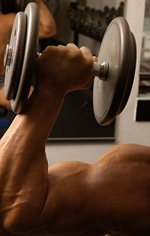
Intraocular pressure (the pressure within the eyeball) is generally decreased after aerobic exercise, such as running and biking, and nonaerobic exercise, including weightlifting, according to background information in the article. However, higher intraocular pressure has been reported during the Valsalva maneuver, in which air is forced against a closed windpipe and pressure increases in the chest. This action occurs during coughing, vomiting, playing wind instruments and sometimes weightlifting.
Geraldo Magela Vieira, M.D., Institute of Specialized Ophthalmology and UNIPLAC School of Medicine, BrasÃlia, Brazil, and colleagues measured intraocular pressure during weightlifting in 30 males age 18 to 40 (average age 26) without glaucoma. The participants, who all had normal (less than 21 millimeters of mercury) eye pressure, performed four repetitions of a bench press exercise in two ways. The first time, pressure was measured in the right eye and the weightlifters held their breath during the last repetition. The second time, pressure was measured in the left eye and the participants breathed normally throughout the exercise. Eye pressure was measured during the fourth repetition.
During the first round of exercise, intraocular pressure increased in 27 (90 percent) of the participants, by an average of 4.3 millimeters of mercury. During the second round, pressure increased in 18 (62 percent) of weightlifters, by an average of 2.2 millimeters of mercury.
The increased pressure could be due to the Valsalva maneuver or a similar motion performed during bench presses; the even higher pressure during the first repetitions “may be due to greater intrathoracic [chest] pressure caused by the air retained in the lungs when the subjects held their breath during intraocular pressure measurement,” the authors write.
